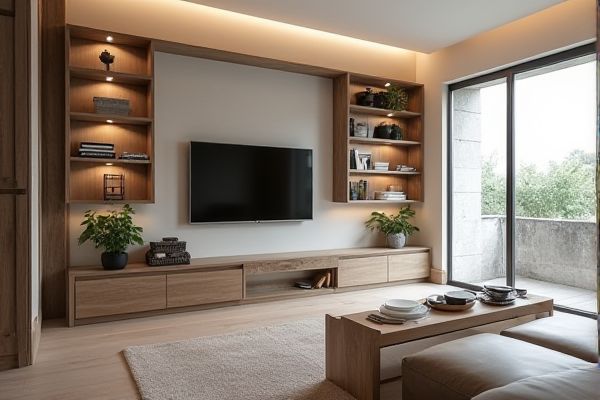
Wall mounted storage maximizes floor space and provides a sleek, modern look, making it ideal for smaller rooms or minimalist designs. Freestanding storage offers flexibility and easy relocation, allowing you to adapt your space as needed; explore the rest of the article to find out which option best suits your needs.
Table of Comparison
| Feature | Wall Mounted Storage | Freestanding Storage |
|---|---|---|
| Installation | Requires wall fixing; permanent | Portable; no installation needed |
| Space Utilization | Maximizes vertical space; ideal for small rooms | Uses floor space; occupies more area |
| Weight Capacity | Limited by wall strength and mounting hardware | Usually higher capacity; stable base support |
| Flexibility | Fixed location; less flexible | Easy to move and rearrange |
| Design & Style | Modern, sleek; blends with wall decor | Varied styles; standalone furniture |
| Maintenance | Easier to clean underneath; harder to modify | Requires floor cleaning; easier to modify |
| Cost | Generally lower cost; installation may add expense | Varies widely; no installation cost |
Introduction to Storage Solutions
Wall-mounted storage maximizes vertical space, offering a sleek and modern solution for organizing items without occupying floor area, ideal for small rooms or offices. Freestanding storage provides flexibility and mobility, allowing easy rearrangement and additional surface space, suitable for larger spaces or frequently changing layouts. Choosing the right option depends on your space constraints, storage needs, and desired aesthetic.
Overview of Wall Mounted Storage
Wall mounted storage systems maximize space efficiency by utilizing vertical wall areas, ideal for rooms with limited floor space. These units provide customizable configurations with options like shelves, hooks, and cabinets, enhancing organization without cluttering the room. Their installation offers a modern, streamlined look while keeping essential items easily accessible and off the floor.
Overview of Freestanding Storage
Freestanding storage offers versatile and movable solutions ideal for organizing various spaces without permanent installation. These units come in diverse styles and sizes, allowing you to customize storage according to your needs and easily reposition them as required. This flexibility makes freestanding storage a popular choice for homes and offices seeking adaptable organization options.
Space Efficiency Comparison
Wall mounted storage maximizes space efficiency by freeing up floor area, making rooms feel more open and accessible. Freestanding storage units occupy valuable floor space, which can limit room layout options and reduce overall usable area. Your choice depends on the need to optimize floor space versus flexibility in rearranging or relocating storage.
Installation and Flexibility
Wall mounted storage requires professional installation involving wall anchors and studs for secure mounting, offering a space-saving solution ideal for small rooms. Freestanding storage provides maximum flexibility, allowing easy relocation and no need for wall modifications, but it occupies floor space and may be less stable. Choosing between the two depends on balancing installation effort against adaptability and room configuration.
Durability and Safety Considerations
Wall-mounted storage offers superior durability by being securely anchored to studs, reducing the risk of tipping and maximizing space efficiency in your home or office. Freestanding storage, while versatile and easier to reposition, may require additional safety measures such as anti-tip brackets to ensure stability, especially in homes with children or pets. Prioritizing wall-mounted units enhances safety by minimizing hazards and prolonging the lifespan of your storage solution.
Aesthetics and Interior Design Impact
Wall-mounted storage enhances interior design by creating a sleek, minimalist look that maximizes floor space and adds vertical interest to a room. Freestanding storage offers versatility in style and placement, acting as a statement piece or functional furniture that complements various decor themes. Both options influence room aesthetics differently: wall-mounted units contribute to a clean, modern feel, while freestanding storage adds warmth and depth through its presence and materiality.
Cost Analysis: Wall Mounted vs Freestanding
Wall mounted storage generally incurs higher upfront installation costs due to mounting hardware and professional labor, whereas freestanding storage offers more budget-friendly options with minimal setup expenses. Over time, wall mounted units may provide better space utilization, potentially reducing the need for additional storage purchases and saving on long-term costs. Your choice should balance initial investment with space efficiency and future adaptability.
Ideal Use Cases for Each Storage Type
Wall-mounted storage is ideal for maximizing floor space in small rooms, providing easy access to frequently used items, and creating a streamlined look in kitchens, bathrooms, or offices. Freestanding storage offers flexibility for rearranging furniture and is well-suited for larger spaces where mobility and the ability to accommodate varied storage needs are important. Both storage types serve specific organizational purposes depending on spatial constraints and functional requirements.
Choosing the Right Storage for Your Needs
Wall mounted storage maximizes floor space and is ideal for small rooms or minimalist designs, offering easy access and a sleek look. Freestanding storage provides greater flexibility in rearranging and often offers more storage capacity, suitable for larger spaces or frequently changing layouts. Selecting between wall mounted and freestanding storage depends on your available space, aesthetic preferences, and specific storage requirements.
 homyna.com
homyna.com